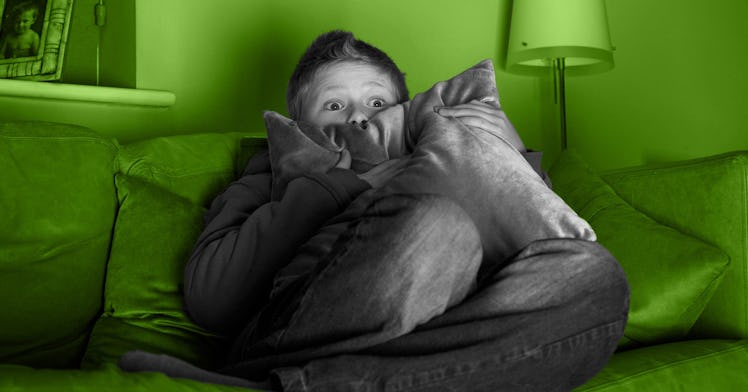How to Help a Kid That is Scared By Movies
It’s not about telling them it’s not real, because for them, it basically is.

Most children don’t have the cognitive ability to separate fact from fiction. It’s all the same to them. So when they first experience something on a screen, be it television or movie, it’s no less real than the people sitting next to them. Even if what they’re seeing is as innocuous as a muppet, it’s still a twisted vision of real life. Elmo talks and acts like a kid, but holy crap just look at him! This break from what they understand as “reality” can cause distress. And every kid processes this break differently, so there’s no telling what’s going to startle them.
“You can’t always know what’s going to trigger a scared reaction from a child. It could be that it reminds them of some other thing that scares them, and the image is triggering to them,” says Sierra Filucci, executive parenting editor at Common Sense Media. “Grotesque faces, things that are outside of realistic faces, or just sweet, relatable big-eye, big-smile faces can be disturbing to kids, and adults don’t really see it that way.”
For adults, it’s all good clean fun and the propensity to react with exasperated bemusement is strong. But one thing Filucci cautions against is the old “don’t worry, it’s not real” discussion. It’s an abstract statement that holds little salt when a child can’t fully discern fact from fiction, and it causes a huge amount of cognitive dissonance because the parent is saying it’s “not real” but it’s right there, five stories high creating a ruckus on screen. Why wouldn’t the kid not be worried?
“Under the age of about 5, they’re not really in a place to process. Up until 7 or 8, kids can’t tell the difference between fantasy and reality. If you’re just telling them ‘don’t worry, it’s not real,’ it doesn’t really mean anything,” says Filucci. “It almost can dilute trust because you’re basically contradicting their experience. It’s more about distraction and comfort. The best response as a parent is either avoiding something you know is going to scare your child or, if it’s already happened, offer them physical reassurance like a hug.”
The trick is for a parent to mindful of both a kid’s fears and the media. “A lot of it is just knowing your kid and avoiding the things that trigger them,” Filucci says. “Sometimes it’s really surprising for parents to see what freaks their kids out.”
But eventually they’ll figure out that for their kid Elmo is basically Leatherface, but they can totally deal with the Lovecraftian creature that lives in an old Ford on that Monster Trucks movie. Once they’re oriented to their kids’ fears, parents should engage in a little research before diving into to some random Netflix weirdness. Watching trailers will help. So will an IMDB movie synopsis or a score of sites dedicated to helping parents know what’s in a movie. Ratings, however, might not help. Hell, Dumbo is rated G but that doesn’t stop it from taking the big-eared elephant through a hallucinogenic drunken nightmare sequence.
That’s why it’s essential for parents to be prepared for their impressionable kid to get triggered by something like a demonic pink elephant. To prepare kids for the experience of fiction on screen, Filucci recommends starting their experience with shorter films at home. That way a parent can pause or stop the movie when they sense that something onscreen is troubling their kid.
Parents also need to be willing to err on the side of caution when a child’s fears are activated. Sometimes that means eating the cost of an expensive movie ticket because something about the film Trolls seems to be traumatizing them. Other times, it means coming to terms with the fact that, no, a 4-year-old isn’t quite ready for Star Wars, despite the parents’ extreme desire to show them.
“If you’re a lover of movies, you want to share that with your kid. Sometimes it’s a little too early,” Filucci says. “They’re going to be exposed to lots of stuff as they get older, and eventually fear changes and wears off.”
This article was originally published on